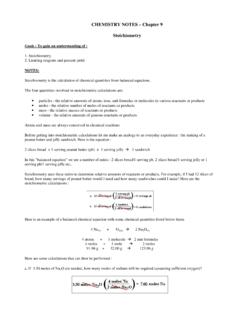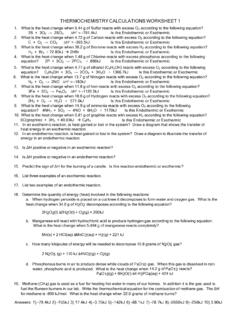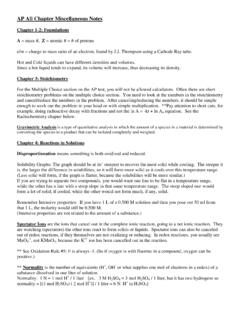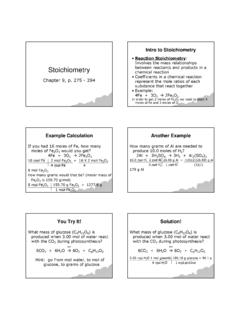Transcription of Chapter 3 Notes - Stoichiometry
1 AP ChemistryA. AllanChapter 3 Notes - Atomic MassesA. C-12, the Relative Standard1. C-12 is assigned a mass of exactly 12 atomic mass units (amu)2. Masses of all elements are determined in comparison to the carbon -12 atom (12C) the most common isotope of carbon3. Comparisons are made using a mass spectrometerB. Atomic Mass (Average atomic mass, atomic weight)1. Atomic masses are the average of the naturally occurring isotopes ofan element2. Atomic mass does not represent the mass of any actual atom3. Atomic mass can be used to "weigh out" large numbers of The MoleA. Avogadro's number1. x 1023 units = 1 mole2. Named in honor of Avogadro (he did NOT discover it)B. Measuring moles1. An element's atomic mass expressed in grams contains 1 mole ofatoms of that elementa.
2 Grams of carbon is 1 mole of carbonb. 12 grams of carbon-12 is 1 mole of Molar MassA. Molar Mass (Gram molecular weight)1. The mass in grams of one mole of a compound2. The sum of the masses of the component atoms in a compounda. Molar mass of ethane (C2H6):Mass of 2 moles of C = 2( g)Mass of 6 moles of H = 6( g) Percent Composition of CompoundsA. Calculating any percentage1. "The part, divided by the whole, multiplied by 100"B. Percentage Composition1. Calculate the percent of each element in the total mass of thecompound(#atoms of the element)(atomic mass of element) x 100 (molar mass of the compound) Determining the Formula of a CompoundA. Determining the empirical formula1. Determine the percentage of each element in your compound2.
3 Treat % as grams, and convert grams of each element to moles ofeach element3. Find the smallest whole number ratio of atoms4. If the ratio is not all whole number, multiply each by an integer so thatall elements are in whole number ratioB. Determining the molecular formula1. Find the empirical formula mass2. Divide the known molecular mass by the empirical formula mass,deriving a whole number, n3. Multiply the empirical formula by n to derive the molecular Chemical EquationsA. Chemical reactions1. Reactants are listed on the left hand side2. Products are listed on the right hand side3. Atoms are neither created nor destroyeda. All atoms present in the reactants must be accounted for amongthe products, in the same numberb.
4 No new atoms may appear in the products that were not presentin the reactantsB. The Meaning of a Chemical Reaction1. Physical Statesa. Solid - (s)b. Liquid - (l)c. Gas - (g)d. Dissolved in water (aqueous solution) - (aq)2. Relative numbers of reactants and productsa. Coefficients give atomic/molecular/mole Balancing Chemical EquationsA. Determine what reaction is occurring1. It is sometimes helpful to write this in word form:Hydrogen + oxygen waterB. Write the unbalanced equation1. Focus on writing correctly atomic and compound formulasH2 + O2 H2OC. Balance the equation by inspection1. It is often helpful to work systematically from left to right2H2 + O2 2H2OD. Include phase information2H2 (g) + O2 (g) 2H2O (l) Stoichiometric Calculations: Amounts of Reactants and ProductsA.
5 Balance the chemical equationB. Convert grams of reactant or product to molesC. Compare moles of the known to moles of the desired substance1. A ratio derived from the coefficients in the balanced equationD. Convert from moles back to grams if Calculations Involving a Limiting ReactantA. Concept of limiting reactant (limiting reagent):" I want to make chocolate chip cookies. I look around my kitchen (I have a BIGkitchen!) and find 40 lbs. of butter, two lbs. of salt, 1 gallon of vanilla extract, 80 lbs. ofchocolate chips, 200 lbs. of flour, 150 lbs. of sugar, 150 lbs. of brown sugar, ten lbs. ofbaking soda and TWO eggs. It should be clear that it is the number of eggs that willdetermine the number of cookies that I can make.
6 "1. The limiting reactant controls the amount of product that can formB. Solving limiting reactant problems1. Convert grams of reactants to moles2. Use stoichiometric ratios to determine the limiting reactant3. Solve as before, beginning the stoichiometric calculation with thegrams of the limiting reactantC. Calculating Percent Yield1. Actual yield - what you got by actually performing the reaction2. Theoretical yield - what stoichiometric calculation says the reactionSHOULD have producedActual Yield x 100% = percent yield Theoretical Yiel











